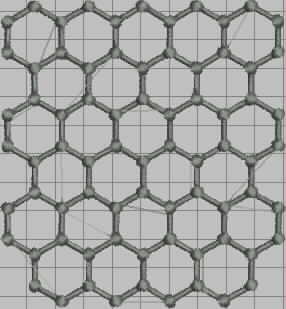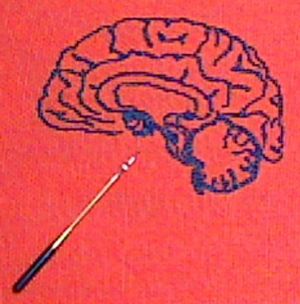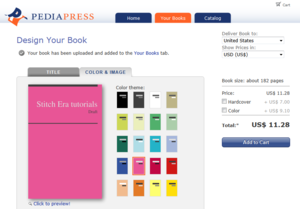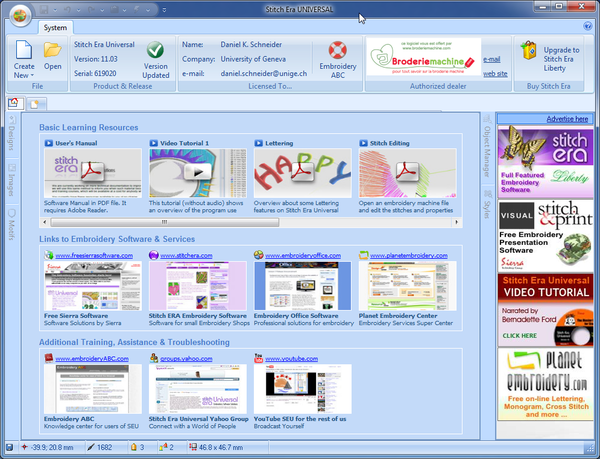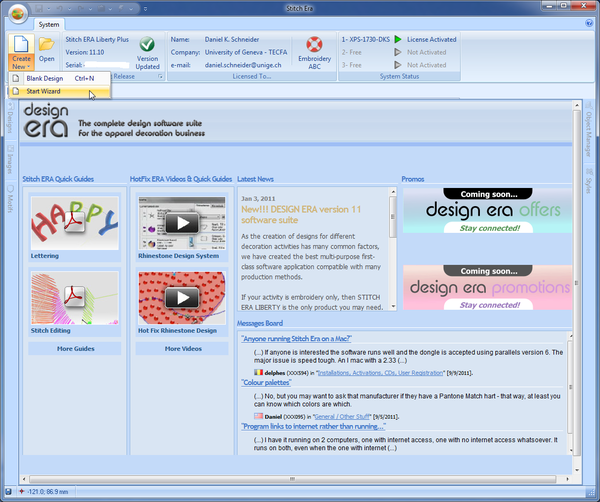Stitch Era embroidery software
<pageby nominor="false" comments="false"/>
Introduction
Stitch Era Universal (sometimes abbreviated as SEU by Sierra is an advanced free embroidery design software. Its features include:
- Built-in vector drawing and import of vector art
- Bitmap tracing (translation to vector drawings) and import of raster files
- Conversion of vector graphic parts (lines and fills) to corresponding stitch sections (both automatics and semi-manual)
- Advanced stitch section editing/configuration, e.g. changing fill patterns, reordering, thread colors, stitch editing, etc.
- Stitch by stitch editing
- Lettering
The free version is plenty enough for learning embroidery and creating fairly complex designs, however for daily use it's better to have Stitch Era Liberty, i.e. the equivalent commercial product. It will load faster and allow for larger designs. It also includes a few extra features like a "redo", more components (e.g. patterns), etc. Currently, Stitch Era is the best free embroidery software for folks with ambition. The Pro version matches in our opinion any other program for home users in the 0-2000 $ price range.
The Stitch Era tutorials - purpose
The purpose of our Stitch Era tutorial series is to help people get going past the very first steps. We are writing down our own experience while we still remember the more difficult issues. We try to group issues in a more natural way, i.e. introduce subjects rather by problem then by tools area. Contents are split over several articles and some topics may be addressed from several angles..
Our target population are rather ICT-savvy people, for example, students in educational technology, graphic designers, or teachers using ICT in education. I expect readers to have some experience with at least some kind of multi-media program, e.g. drawing, CAD, image manipulation, multi-media animation.
Disclaimer: I started learning embroidery in mid-may 2011 and I only aim to understand basic principles, therefore don't trust everything. Think ! Tutorials will improve over time, but I don't plan going very far, i.e. I am curious about most technologies (there are many to explore). I teach computerized embroidery as a module in a small design and micro-fabrication class for educational technologists. While I am working on a topic, contents may change every 5 minutes or so. Reload if there is a problem, e.g. a missing picture. - Daniel K. Schneider 16 May/19 June/29 sept. 2011.
List of Stitch Era tutorials
List of Stitch Era (v.11) beginners tutorials:
- Stitch Era - simple digitizing (probably the best place to start)
- Stitch Era - adjusting stitch sections
- Stitch Era - lettering
- Stitch Era - vector graphics
- Stitch Era - interface features for working with a design
- Stitch Era - trouble shooting
- Stitch Era - vector and thread color
List of Stitch Era v.11 intermediate tutorials:
Each tutorial is a draft and needs further work !
General articles about computerized embroidery:
- Computer-controlled embroidery and sewing
- Concepts of computerized embroidery
- Computerized embroidery in education
- Conference embroidery
Tips for using the tutorials:
- For navigation between various embroidery articles and tutorials of the on-line version, you also can use the little expansion menu to the right. Click on the little [+] to expand You will find this button on top right of each embroidery page.
- Most images in articles can be enlarged by clicking on them... I usually reduce pictures to 400, 600 or 800 pixels in order to make them fit a small display area.
Print versions
You can print whole sets of articles and tutorials as on-demand Wikibooks in a single PDF or order a bound version through the PediaPress service. On-demand means that the whole texts will always take into account the latest changes. You will need some patience.
- EduTech Wiki:Books/Stitch Era basic tutorials (free PDF or Pediapress). Includes the Stitch Era beginners tutorials only (as of July 7 2011: >30MB. The Pediapress version has about 150 pages of content and costs about $12)
- EduTech Wiki:Books/Stitch Era tutorials (free PDF or Pediapress). Includes the Stitch Era tutorials only (as of July 7 2011: >45MB). Intermediate tutorials have rough draft quality.
- EduTech Wiki:Books/computerized embroidery (free PDF or Pediapress). Includes all embroidery-related articles. Probably more than you want, > 50MB.
Contents of wiki pages, PDF or Pediapress books are all the same. Online wiki pages are much better, since you always can enlarge the pictures. Pediapress books are better than PDF with respect to most criteria and cheaper than printing on an Ink-jet home printer. Either don't print or else print at work. I don't earn any money with Pediapress, it's really just a print-on-demand service made initially for Wikipedia. If you save HTML or PDF files to your local computer, make sure to check for updates. All wiki entries are often updated, sometimes substantially.
Some use cases of Stitch Era
Stitch Era is a versatile design suite that can be used in various ways. It's suitable for both absolute beginners with a good technical background (e.g. Vector drawing, Multimedia animation, 3D modeling) and semi-professional embroidery folks. So far, I am quite impressed with this software and believe that it can beat most other consumer products
There are different ways to create embroidery with this program and we shall describe a few. A design workflow pipeline may include many or very few steps. Any of these ways can be combined. E.g. in a design, you could import some vector graphics, import a bitmap and vectorize it, draw some elements yourself, digitize and finally use the lettering module. Diagrams error (with dot command): Error: /tmp/diagrams_inc0697df7558f.dot: syntax error in line 2 near '['
Let's now briefly discuss some of these strategies. Lines that are dotted are either not recommended or not addressed in our tutorials.
(1) The easy imported image route
- Import a bitmap picture
- Reduce its colors
- Translate is to a vector image (this is called vectorizing)
- Clean up a bit and auto-digitize to stitch sections. You can define a series of global parameters that define how lines, "columns" and larger areas should be rendered. Typically, you would set stitch density and select a fill pattern.
- Tune the stitch sections if needed. This is optional, but required for quality output.
- Read Stitch Era - simple digitizing and (optionally) Stitch Era - digitizing complex bitmap images
(2) The easy imported vector graphics route
- Import either Illustrator (AI) or Corel Draw (CDR) or a lossy Windows EMF/WMF files
- As above, this procedure may need cleaning at both vector and stitch section level
Read Stitch Era - simple digitizing and (optionally) Stitch Era - digitizing complex vector images
(3) The lettering route
- Create letterings with the built-in lettering module
- You then also can tune stitch objects or just create stitches and the machine code file
- Read Stitch Era - lettering)
(4) The SE vector graphics route
- Draw vector graphics with Stitch Era
- Digitize to stitch sections
(1-4) Tuning Stitch sections For all these four routes and combinations you likely will have to:
- Tune stitch sections (read Stitch Era - adjusting stitch sections). There are dozens of parameters you can set and you also may have to fix shapes of these objects. Some parameters can be set before you digitize from vector graphics.
- Tune colors if needed (read Stitch Era - vector and thread color
- Translate to stitches (if needed, read Stitch Era - trouble shooting (in particular the stitch colors section)
- Generate the machine code file
In addition:
- You may have to redraw or to re-digitize a single object.
- You must be aware that you will have imported pictures, vector graphics, stitch sections and stitches in the same workspace. You can work on any of these and also "re-translate" single elements (e.g. a re-drawn vector object) if needed.
(5) The SE stitch section drawing route
- Draw stitch sections (instead of starting with vector graphics) and parameterize stitch generation
- Work with sub-sections, define entry/exit points, define thread cut on/off, change stitch direction, etc. not covered in this wiki!).
(6) Assembly coding
- Insert stitches click by click (that's more for the professional)
- Move some stitches or add some extra stitches (I just do this occasionally)
These strategies can be combined, e.g. you could start by auto-digitizing a vector image, then change parameters and shape of generated stitch sections and finally manually add some stitches or create a drawing with Stitch Era and then digitize it.
Availability and download
Stitch Era Universal
You can get the free Stitch Era Universal under certain conditions:
- You only get it from an authorized dealer. E.g. since I live in France, I got it from the french authorized reseller. For countries like Switzerland that do not have authorized resellers, you can directly download from Sierra (tested for our lab computers). Download may take a long time (on my end I have a Gigabit line).
- You need to register and obtain a license number and key (and renew these periodically)
- The application must be connected to the Internet permanently and there are advertisements. However they don't flicker, just eat up some space to the right.
- The free version limits stitch count to 40'000 stitches. That's a fairly large design, unless you fill up all the space with stitches.
Stitch Era Universal is distributed by Authorized Distributors (either via CD or online) unless you are lucky to live in a country without. Installation and use requires a permanent Internet connection. Software contains advertising. Download can take a long time and you need to find a download site for your country (e.g. for France use Annika's site). You first have to install a downloader, then a download the > 400 MB installation files with the downloader program. I also acquired the commercial version from the same vendor (Annika). They ship to any country, her e-commerce site is professional and delivery was fast.
After going through the complicated finding-a-place-to-download, the double download and authentication, we found that this program runs fine on Win 7 64 bit.
Stitch Era Liberty
The pay version called Stitch Era Liberty is available through authorized dealers or Sierra. Unfortunately is requires a Dongle. It seems to me that Sierra could have made an effort for providing alternative online authentication. On my computer I got dozens of expensive programs and managing (including not loosing) dongles is not an acceptable option.
Installation is a bit less complicated as the free version:
- Before installation, you will have to require an installation key using a serial number and another code from http://www.d-era.com/services
- The software then must be installed with the plugged Dongle
- In order to receive upgrades, the product also must be registered. That can be done within Stitch Era.
After this procedure, the program hung up after I started, registered and tried to open a file. After killing the process and a restart of the program, all went fine. Files now load much faster and I got bigger screen estate.
The user interface
The SEU start up screen
At start up, Stitch Era Universal software that does have a license and a key may roughly look like this:
The start-up screen of the commercial Stitch Era liberty version looks a bit different:
Before you click on Create New, we suggest downloading the manual and read some of it (first item under Basic Learning Resources in this start-up screen).
Otherwise, if you plan to dive in:
- Create New (top left)
- Select Quick start in the pull down menu
- Select Quick start with a Blank Design Using a Simple Wizard in the Start Wizard
- You then can specify textile and hoop size (ordered by machines). For a typical small embroidery you likely will have something like a 12.6x11cm hoop.
The interface is fairly complex and we really suggest reading at least parts of the manual and/or looking at some training videos. Links for documentation is available in the start-up screen for example. An other alternative is to go through our own tutorials, starting with Stitch Era - simple digitizing for example. In addition, we also suggest having a glance at Stitch Era - interface features for working with a design. However, our target population for these tutorials are people who already do have some experience with multi-media programs and we cannot explain in detail typical standard operations.
Main principle
The most important and confusing concept that one must understand is that Stitch Era includes both a drawing and image file management component (what they call Artwork) and an embroidery object component (so called "stitch sections"), i.e. objects that define stitching information with many parameters.
Both components - vector drawing and stitch object drawing - are fairly independent, i.e. one can work with vector graphics without thinking embroidery and one can define embroidery objects without doing an vector graphics. Of course, the purpose of vector graphics is to make stitch object creation easier, e.g. through a process called auto-digitizing.
Elements of the user interface
The annotated screen capture to the right shows the most important areas of the user interface. You can ignore the details for starters and jump right into the recommended tutorial for beginners, i.e. Stitch Era - simple digitizing. However, please locate the Object manger (vertical tabs to the right). We shall use it very often. Also, you should be aware all the time whether the tiny little vectors and embroidery buttons (to the upper right of the workspace (the big panel in the middle) or "on" (green) or off ("red") or inactive ("grey").
The various areas of the user interface correspond to these functions. However an exact same task often can achieved through three ways.
- File Menu button and quick access toolbar
- Main tools / Ribbon bar. This toolbar will adapt to the current task.
- Document bar
- Select and stitch create tools / color management
- Display, reference and simulation controls (at the bottom)
- Object manager, Inspector and Styles
A few tips:
- Depending on user action (the task you are performing) the main tools bar on top will change. Hit F11 if you feel that you are in the wrong tool. F11 will select the current object and put the mouse in selection mode.
- Many objects in the workspace can be manipulated through a context menu, i.e. click the right mouse button after selecting an object and see...
- The object manger to the right (open it) allows to change properties of objects already created. You can make changes to objects either through the object inspector (will show below the object manger) or a tool that will show in the main menu bar.
You also may read Stitch Era - interface features for working with a design for additional tips on the user interface. However, various design tools and features will be introduced throughout all the other tutorials.
Drawing capabilities
A beginner probably would like to start by digitizing existing bitmap or vector art. Read [Stitch Era - simple digitizing]] and Stitch Era - adjusting stitch sections. Using built-in lettering is another easy thing to do. Read Stitch Era - lettering.
After this, you probably would like to create your own design. In stitch era you either can draw vector graphics first and then convert these to stitch sections (that are also some kind of object-oriented graphics) or you can directly draw stitch sections. Instead of using Stitch Era for drawing, you also can import vector graphics made with another program.
Stitch sections are also a kind of vector graphics, but define how a given object - e.g. a line or a surface - should be embroidered. These Stitch sections contain lots of parameters that define how they should be rendered with stitches. Stitch sections are objects that define a surface or a path to be stitched in the same way. E.g. they include definition about thread color (also called "needles"), density, fill patterns, entry and exit points, stitch directions and much more.
Since my background isn't embroidery I much prefer to work with the easier to manipulate vector graphics first and then work with stitch sections. Other people may prefer the more direct route.
Vector drawing
To create vector graphics, click on Artwork (top menu). Read Stitch Era - vector graphics
You can create vector graphics with seven tools:
- By vectorizing bitmap (raster) images
- By importing vector files and/or by pasting from drawing applications
- Closed shapes (a set of predefined shapes)
- Open Shapes (a set of predefined pathes)
- Text (not the same as built-in lettering...)
- Bezier: draw so-called Bezier curves
- FreeHand: draw freehand (with optional smoothing)
Once you created vector objects with any of these tools you can modify them in several ways:
- Clicking on an object shows controls that you can manipulate in order to change their path or shape. Read Stitch Era - vector graphics.
- Pressing the CTRL button allows to rotate most parts
- Right-click (context menu) gives various options
Constructive solid geometry
- You also can define new shapes by combining shapes like in some CAD/CAM programs, e.g. you could subtract one shape from another like creating moon with two circles. Use the Combine menu for that. If found this feature very practical for dealing with imported vector art or vectorized bitmaps.
Vector graphics - whether imported, created from bitmaps or drawn, then must be converted to stitch sections. There exist two quite different ways:
- Fully or half automated conversion by selecting an auto-digitizing tool like "Art to stitch" all, area or line only.
- More manual conversion by selecting a Stitch from Vector tool. Typically you would convert one kind of vector at a time.
Stitch sections are not connected to vector graphics. E.g. you could delete vector graphics without affecting generated stitch sections and the other way round. You also could create various stitch sections from the same vector object ...
Vector graphics can be hidden by clicking on the Vectors button (top right of files bar). The same is true for stitch sections and imported bitmaps.
Drawing embroidery objects
Instead of drawing vector objects first you can directly create embroidery objects, i.e. stitch sections.
- Select embroidery in the main menu bar on top or select "Create Sections" in the little design panel to the left.
- There are different kinds of stitch sections (more to come ....)
Read Stitch Era - adjusting stitch sections and Stitch Era - digitizing difficult images in order to learn some basic operations.
In short, drawing and manipulating stitch areas combines operations of vector graphics with stitching parameterization. In more simple terms, you can draw the shape of stitch objects plus tell how these objects will be stitched by defining many parameters.
Links
- Official
- http://www.d-era.com/ Website #1 (purchase and services)
- Stitch Era Universal Website #2 (free version)
- Stitch Era website #3
- EmbroideryABC website #4 (support for the free Universal version)
- Official documentation and forums
- Stitch era distributes a nice 250 page printable PDF manual (see the start page). Last time checked it was here.
- The Stitch era community forums
- Yahoo group StitchEraUniversal
- YouTube training and demo videos
- Tutorials in other languages
- Tutorials vidéo et traduction française du manuel par Chantal.
- Stitch Era Universal version 11 Tuto 1. Inclut des vidéos YouTube. Pour débutants.
Acknowlegments
- Comments for the SEU workflow model: Ian "zoom monster" from the Yahoo Stitch Era group
